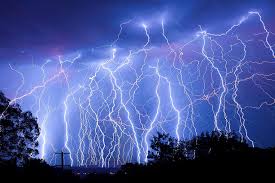Lightning is the third leading cause of weather-related deaths, right behind floods and tornadoes. More people die or are injured by lightning more in the summer months than any other time of the year. This is caused by the increase in thunderstorm activity combined with more outdoor activates.
What is lightning
Lightning is a powerful sudden flow of electricity (an electrostatic discharge) accompanied by thunder that occurs during an electric storm. The discharge will travel between the electrically charged regions within a thundercloud, or between a cloud and a cloud, or between a cloud and the surface of a planet. The charged regions within the atmosphere temporarily equalize themselves through a lightning flash or strike.
If you can see or hear lightning, follow the 30-second rule. Count the seconds, between a lightning flash, and the sound of the thunder. If the time between the lightning and thunder is less than 30 seconds, that means you are within the danger zone and need to find a safe spot.
So what do you do if you are caught outdoors in a thunderstorm.
The first thing you should do is get away from anything that can attract a lightning strike. This could include ridgelines, open fields, lone trees or isolated groves, tall, prominent outcroppings, telephone poles power lines and any other tall objects. Surprisingly small sheds, picnic shelters, recesses in rock cliff faces and the mouths of caves are also dangerous choices. Lighting can hit the tops of cliffs and travel down the faces, this can kill or injury people in recesses or the mouths of caves.
If you are caught in an open field with no shelter, go to a low-lying, open area away from trees, poles or other tall objects. Pick a place that is not subject to flooding. Squat low and have as little contact with the ground as possible; make yourself the smallest target possible. Do not lie flat, as this makes you a bigger target.
If you’re boating or swimming, get on dry land, and find shelter immediately. Stay away from rivers, lakes and other bodies of water.
Whenever possible, take shelter in substantial, permanent, enclosed structures. Avoid unprotected gazebos, picnic shelters, baseball dugouts and bleachers; these structures are often isolated and located in otherwise open areas, making them a target for lightning.
If there are no good buildings, you can take shelter in a car or truck. Keep the windows closed. Although rubber tires provide little protection from lightning, the steel in the vehicle does increase protection, especially if you are not touching metal.
Don’t under estimate the dangers of a thunderstorm. As well as lightning, you can have rain, hale high winds or even tornados. If you possibly can, avoid them or find good shelter.
Howard


This is a spot on tips and guides. One more thing, if you are in the middle of a vast open area and you have anywhere else to take shelter to, lie down on the ground.
Everything I have read and been taught says don’t lay down. You have more of your body in contact with the ground and you make a bigger target.
Howard